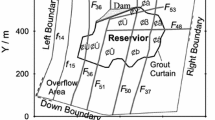Conclusions
-
1.
The low permeability and high tectonic compressive stresses in the rock mass made it possible to locate the chamber-type underground structures in the upper pool of the dam under the reservoir bed. In connection with the poor effectiveness of plugging the rocks by grouting under such conditions, a well drainage curtain located on the upstream side of the grouting zone was used as the main measure on protecting the underground chambers from seepage.
-
2.
The high effectiveness of investigating three-dimensional flow in three-dimensional electrolytic EHDA models with simplication of complex drainage devices in them by using the analytic solutions of appropriate fragments was shown.
-
3.
As a result of investigating seepage in the foundation of the Rogun hydroelectric station the following main comparative characteristics were obtained:
In the absence of drainage the linings of the gate hoisting chambers of the diversion tunnels will experience a pressure up to 2.50 MPa;
With operation of just the main drainage system of the PHC this pressure decreases to 1.80 MPa;
With the combined operation of the drainage systems of the PHC and gate works of the diversion tunnels the seepage pressure on the linings of the latter decreases to 0.08–0.32 MPa;
With the operation also of the local borehole drainage of the hoisting chambers the pressure in the stretch of the boreholes decreases to 0.01 MPa;
With the combined operation of the main drainage systems of the PHC and gate works of the PHC receives 12,300 m3/day of water and the drainage system of the gate works 7650 m3/day. Operation of the borehole drainage increases the seepage flow to the chambers negligibly, by about 300 m3/day.
Similar content being viewed by others
Literature cited
V. F. Ilyusin and N. V. Kolichko, “Effect of engineering-geologic factors on the layout and design of underground structures of the powerhouse complex of the Rogun hydroelectric station,” Tr. Gidroproekta, No. 82.
L. G. Osadchii, V. F. Ilyushin, and I. S. Bubman, “Progressive solutions in the design of underground structures of the Rogun hydroelectric station,” Gidrotekh. Stroit., No.6 (1980).
I. S. Ronzhin and A. I. Satarin, “A three-dimensional EHDA device for solving seepage problems,” in: Joint Conferences on Hydraulic Engineering [in Russian], No. 21 (1965).
R. Kh. Bukhairov, L. G. Osadchii, and R. Zh. Madgazin, Inventor's Certificate No. 891829, “Method of modeling seepage flow by the electrodynamic method,” Byull. Izobret., No. 47 (1981).
V. I. Aravin and S. N. Numerov, Seepage Calculations of Hydraulic Structures [in Russian], Stroiizdat, Moscow-Leningrad (1955).
L. N. Pavlovskaya and V. M. Shestakov, Methodological Instructions on Seepage Calculations of Groundwater Lowering Devices [in Russian], Gosénergoizdat, Moscow (1961).
V. M. Shestakov, Groundwater Dynamics [in Russian], Moscow State Univ. (1973).
V. M. Nasberg, “Seepage calculation of borehole drainage serving to relieve groundwater pressure on the lining of tunnels and shafts,” Izv. TNISGÉI,16 (1966).
Additional information
Translated from Gidrotekhnicheskoe Stroitel'stvo, No. 5, pp. 36–40, May, 1984.
Rights and permissions
About this article
Cite this article
Bukhairov, R.K., Yugai, A.I. & Ilyushin, V.F. Selection and substantiation of effective drainage protection of the gate works of the diversion tunnels of the Rogun hydroelectric station. Hydrotechnical Construction 18, 234–240 (1984). https://doi.org/10.1007/BF01428826
Issue Date:
DOI: https://doi.org/10.1007/BF01428826




